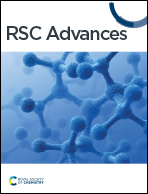Crystal structures, phase transitions, and nuclear magnetic resonance of organic–inorganic hybrid [NH2(CH3)2]2ZnBr4 crystals†
Abstract
Organic–inorganic hybrid [NH2(CH3)2]2ZnBr4 crystals were grown via slow evaporation, and their monoclinic structure was determined using single-crystal X-ray diffraction (XRD). The two phase transition temperatures at 401 K (TC1) and 436 K (TC2) were defined using differential scanning calorimetry and powder XRD. In the nuclear magnetic resonance spectra, a small change was observed in the 1H chemical shifts for NH2, 13C chemical shifts for CH3, and 14N resonance frequency for NH2 near TC1. 1H spin-lattice relaxation times T1ρ and 13C T1ρ for NH2 and CH3, respectively, rapidly decreased near TC1, suggesting that energy was easily transferred. NH2 in the [NH2(CH3)2]+ cation was significantly influenced by the surrounding environments of 1H and 14N, indicating a change in the N–H⋯Br hydrogen bond with the coordination geometry of the ZnBr4 anion. These fundamental properties open efficient avenues for the development of organic–inorganic hybrids, thus qualifying them for practical applications.
![Graphical abstract: Crystal structures, phase transitions, and nuclear magnetic resonance of organic–inorganic hybrid [NH2(CH3)2]2ZnBr4 crystals](/en/Image/Get?imageInfo.ImageType=GA&imageInfo.ImageIdentifier.ManuscriptID=D2RA06697A&imageInfo.ImageIdentifier.Year=2023)


 Please wait while we load your content...
Please wait while we load your content...